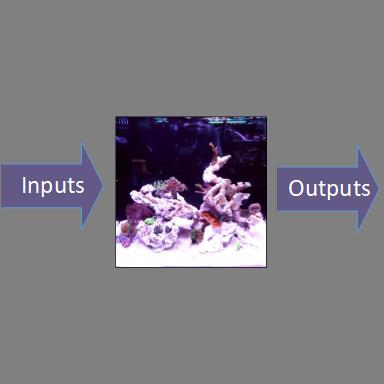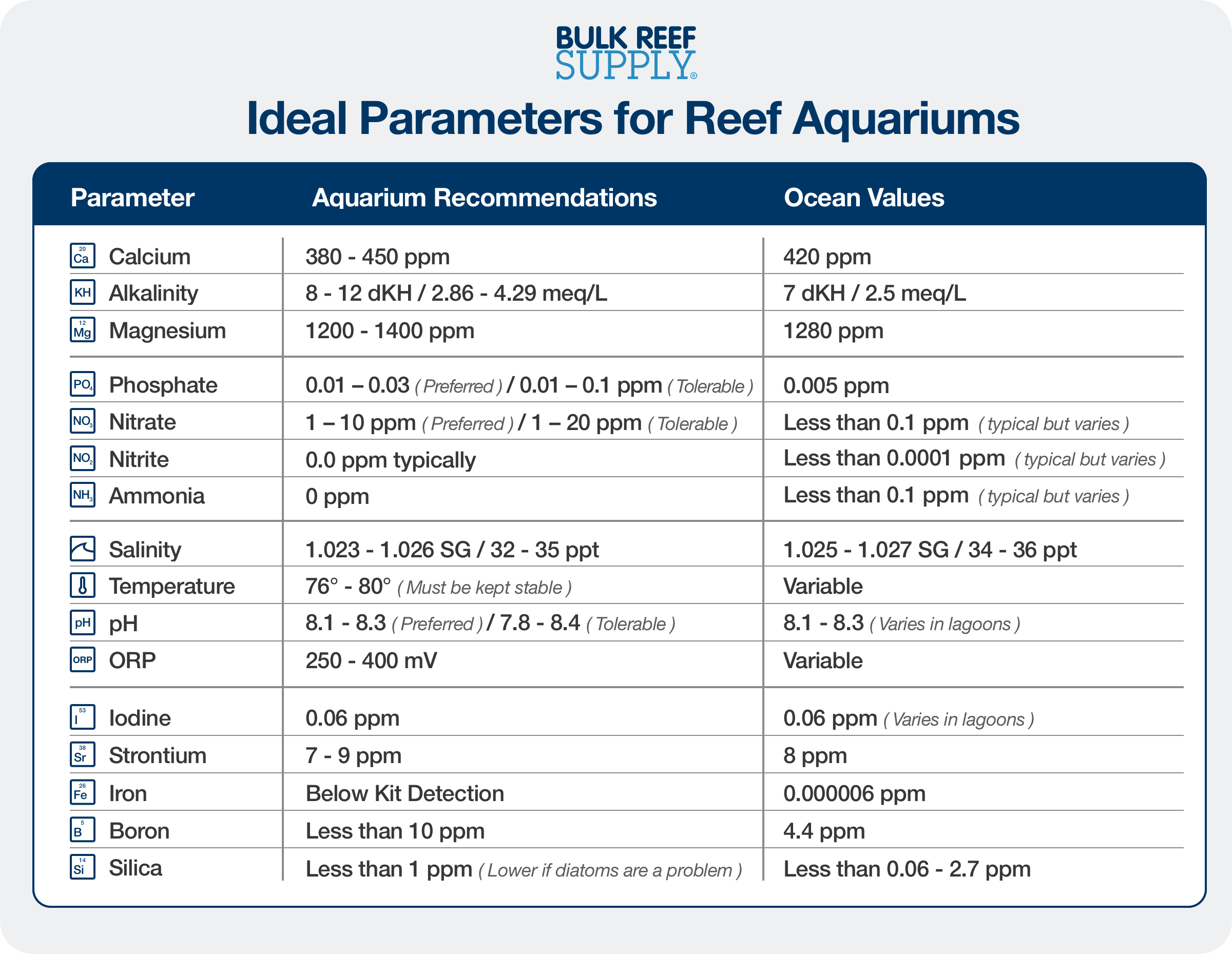
Preface: This Reef Mentoring article series is to document my recommendations to a hobbyist I have been mentoring. I am basically building a reef tank with his setup at my house and maintaining it for a year with weekly hands on sessions.
After introducing all the planned livestock (and even some test subjects into the new tank) it is time to allow the system to settle. Considering this is a nano reef tank, fluctuations tend to be higher with respect to water parameters and nutrient levels. Smaller water volumes have less room for error. The key to success is maintaining the correct levels of inputs and outputs in a closed system. This allows the natural biological filter to process the wastes produced and all required elements are present for healthy livestock growth.
As a product development systems engineer, a simple tool called an Input / Output Chart is used for collecting information. Brainstorm every input that can possibly enter/affect the system. What is stays in the system? List every output that can exit it. It can be as basic or complex depending on the level of detail it needs to be complete. This can be broken down to whatever level you would like. If you truly want to understand how every subsystem works in relation to the whole, spend the time. A true systems understanding will allow the aquarist to determine what the most important interactions are and prioritize to focus on them.
Keepers of Water
In my opinion, water quality is the most important factor. The most common simplification of our hobby is “we are keepers of water.” If we can do that well we can all be responsible and successful reef keepers with today’s technology and understanding. Let us brainstorm some of the most obvious inputs and outputs with regards to water quality as a sub-system of the reef tank ecosphere.
System: Reef Tank Ecosphere
- Energy: Electricity –> Photons from Lights
- Hardware: Tank (water volume and dimension), lighting (Photoperiod, spectrum and Intensity), mechanical, chemical, and biological filtration equipment, flow pumps, heater, supplement devices, and controllers
- Sea Water: synthetic salt, water, organic nutrients, major and minor trace elements
- Organisms: micro fauna, corals, invertebrates, fish
- Environmentals: oxygen, carbon dioxide, temperature, humidity, contaminants
Focused Sub-System: Sea Water Soup
Understanding what is actually in the saltwater soup box is important. It provides a road map of the interrelationships that will determine the quality of the enclosed box of water you are trying to maintain .
- Synthetic Sea Salts w/ various levels of major and minor trace elements
- Quality Water
- RO/DI clean water measured in Total Dissolved Solids (<5 ppm TDS)
- RO/DI waste & filtered contaminants (silicates, chloramines, etc.) removed in filtration process
- Organic Wastes
- Decaying organic matter (ammonia, nitrates, phosphates)
- Fish consume foods to create tissue and metabolic waste (carbon dioxide, ammonia, nitrates, phosphates)
- Corals consume food and major/minor trace elements and produce metabolic waste (carbon dioxide, nitrogen, phosphorous)
- Stony corals consume major & minor trace elements to develop tissue and limestone skeletons
- Coral metabolic wastes are utilized by photosynthetic zooxanthellae to produce carbohydrates for corals to consume.
- Invertebrates consume foods (algae, detritus, organics, major/minor trace elements) to produce tissue and skeletons and metabolic wastes (ammonia, nitrates, phosphates)
- Photosynthetic Algae
- Consume organic wastes and major/minor trace elements to produce tissue.
- Marine microbes
- Consumes dissolved organic carbon (sugars, proteins, and other compounds)
Testing for Understanding
The elements listed above directly impact reef water chemistry. How do we determine the water quality? The answer is water parameter testing and monitoring. You do not have to constantly chase exact numbers, you just need to maintain parameters within a range that reflects what is recommended for reef tanks or natural seawater . A nice table of the ideal reef water parameters is found on Bulk Reef Supply’s Website.
Caution: Never dose anything into the tank that cannot be measured to determine the impact.

You can acquire hobby-grade titration test kits and some handheld Hanna testers for the top 10 items. I will be automating the testing of calcium, alkalinity, magnesium, and nitrate with a Reef Kinetics Reefbot V1 that utilizes some of these off the shelf reagents. The Reef Mentoring project tank includes a basic controller with temperature and pH probes. Optional modules and probes for salinity and ORP monitoring may be added as needed. Major and minor trace elements would require ICP testing to determine existing levels. This would only be needed if you are experiencing an issue you cannot explain with the home test kits. I do recommend performing ICP testing on some regular basis to provide a baseline over time.
Caution: Testing multiple times to check for repeatability and comparing with other references for accuracy maybe be necessary to gain confidence in the outcomes. Some major sources of errors are typically from the user or reagent quality.
Input: Element Replenishment Strategies
Stability of all the water parameter elements will depend on your replenishment and export strategy. There are a few basic solutions to accomplish this.
- Perform regular water changes (the quality of salt would be a factor to understand)
- Perform 2 Part Dosing or Balling Method + Trace Element Supplementation (Use off the shelf general solutions or dose individual elements)
- Perform Kalkwasser Dosing + Trace Element Supplementation (Either with combination element mixes or dosing individual elements)
- Increase Organic Nutrients via addition of fish, increased feeding, or chemical supplementation.
Depending on the size of the system and the metabolic rate of the livestock, it may even be beneficial to perform a combination of the above to replenish elements and nutrients.
I typically do not perform large water changes on my 510 gallon main system but will change a small percentage during my weekly detritus removal tasks. I also dose calcium hydroxide (primarily for balanced alkalinity and calcium) and dose individual elements as required per the test data.
On this 30 gallon all-in-one system it is possible to perform any of the options above. I chose to perform a cascading hybrid method and perform larger percentage water changes with water from my main system. I will perform some large water changes with fresh saltwater if I deem it necessary to make safe fallback corrections. The key is to know what options you have and how to apply them. Every solution has its own pros and cons. I have tried them all and settled on what worked best for my setup and the livestock I am keeping.
- Do not overreact to test results since a drastic correction can be more detrimental. Gradual corrections over a few days are best.
- Water changes are the safest fallback method to reset your water quality to a known baseline. The freshly made saltwater should match the salinity and temperature of your system prior to using. In some rare cases, pre-testing freshly mixed saltwater can be done if there are concerns with a particular batch of salt.
Output: Basic Export Strategies
The saltwater aquarium system will have wastes and elevated elements that cause an imbalance in the water quality. To maintain the water parameters as suggested by the above table we need to understand what and how to remove them.
Caution: The system can be too clean and the livestock will suffer if the required elements and organic nutrients (nitrates and phosphates) are not present.
- Vacuum detritus, bacterial films (cyano bacteria and dinoflagellates) and algae during water changes.
- Mechanical filters and skimmers will separate and remove solid wastes and organic films. Remove or clean the media regularly.
- Chemical filtration will bind some wastes and contaminants out of the water column. Replace the media regularly.
- Biological filtration, with the aid of bacterial colonies and photosynthetic organisms, will consume some of the nitrates and phosphates in the water column that build up over time. Phytoplankton, algae, and zooxanthellae cells consume nitrates, phosphates and other elements during photosynthesis. Macro algae can be grown and harvested to removed these excess nutrients from the system.
- Water clarification aids:
- Ozone controlled with an ORP Controller increases oxidation to break down coral toxins, wastes, and tannins leached into the water.
- Advanced – Careful 3% hydrogen peroxide dosing can also increase oxidation (1ml per 50g to max of 1ml per 10g) when lights are out. This could be used as a daily maintenance oxidizer in place of ozone or as a periodic treatment for dinoflagellates. An ORP monitor should be used to track the impacts. Caution: Hydrogen Peroxide may have negative impacts on some inverts and SPS corals and your mileage may vary in terms of outcomes.
- Ultraviolet sterilizing can help minimize free floating algal spores, pathogens and bacteria.
Vigilant Monitoring
All the above is important, but vigilant monitoring of parameters and livestock health goes hand in hand. Automation helps but this is not a “set it and forget it” hobby. There currently are no hobby grade systems available that will monitor and control every aspect required. The hobbyist is the one who drives the success or failure of the system. There are still many variables that are outside the aquarist’s control. Bad things still happen in a mature system when dealing with living things so do not be discouraged. As stated prior, there is no guaranteed solution for success since every person’s aquarium ecosystem behaves differently. Building your tool box of knowledge is the best strategy.
Next Steps
The Reef Mentoring system is well into its infancy stages and will most likely enter some form of the “ugly phase”. I am sure there will be issues we will need to resolve as we learn to characterize the system’s behavior over time.
Till the next time, happy reefing!










0 Comments